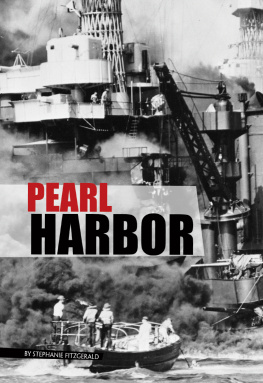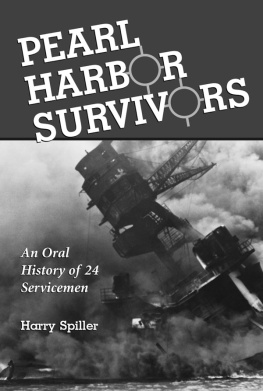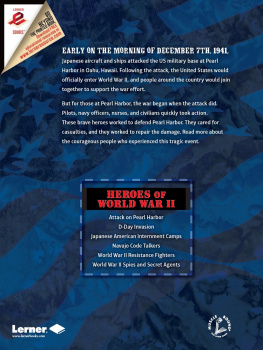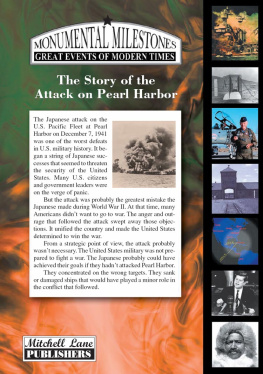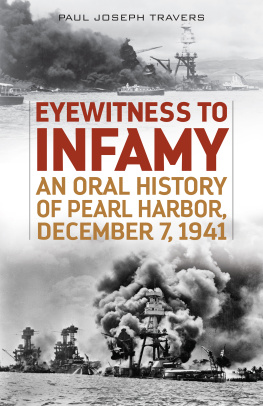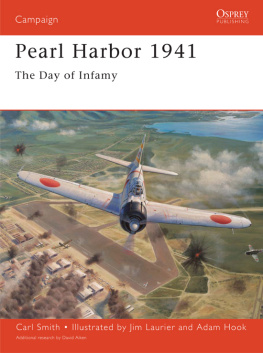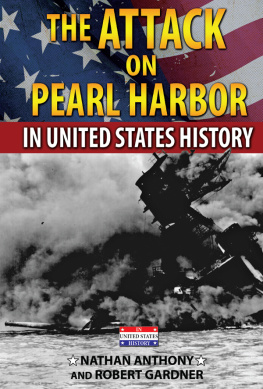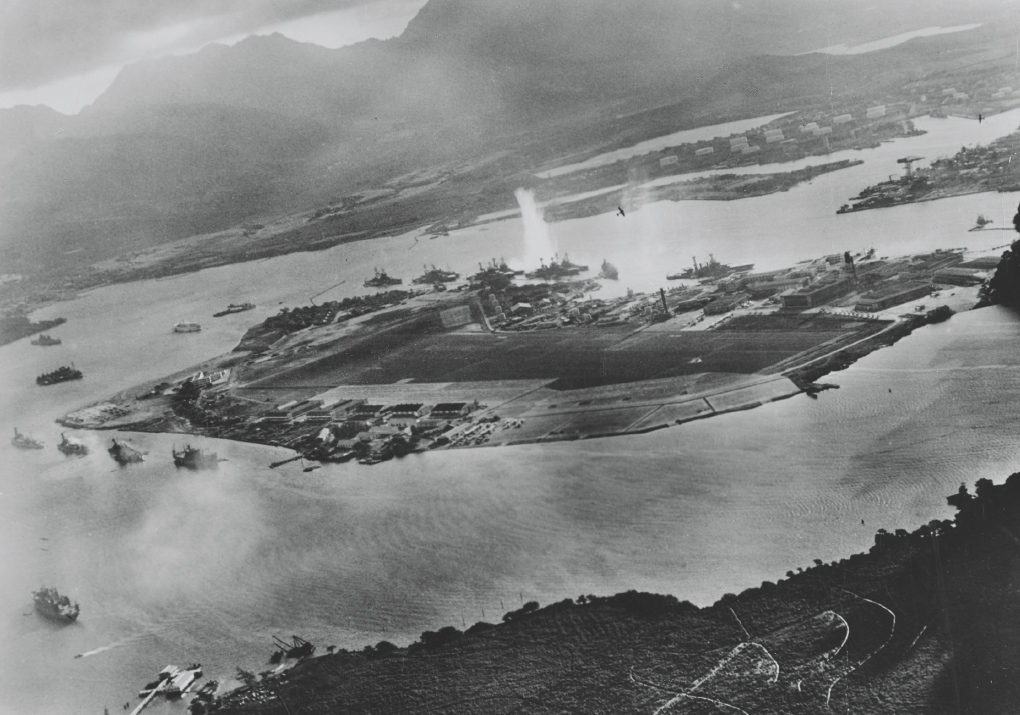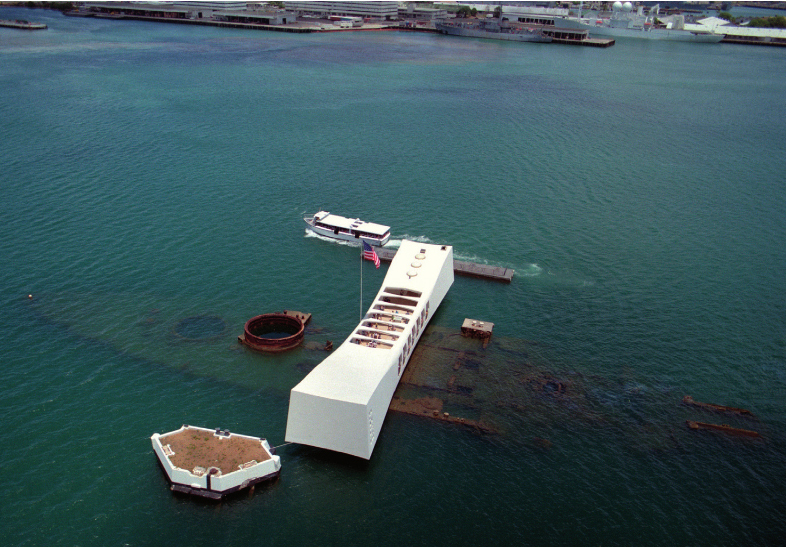CHAPTER ONE
SURPRISE ATTACK
Dave Smith woke up at about 7:30 the morning of December 7, 1941. Smith was a navy seaman apprentice serving aboard the battleship USS Utah. The ship was docked at Pearl Harbor naval base on the Hawaiian island of Oahu. Wearing only his boxer shorts, Smith left his room and walked up to his locker on the old gun deck. He started to get dressed, but he never got the chance.
The USS Shaw exploded after it was bombed by Japanese pilots during the attack on Pearl Harbor.
Smith was surprised to hear the sound of an airplane. It was Sunday morning, and most of the sailors and pilots stationed at the base werent working that day. He looked out a dropped from the plane and slammed into the ship. As the plane climbed, Smith could see a large red circle under both of its wings. Suddenly he understood. This was no training exercisethe plane was Japanese, and Pearl Harbor was under attack!
The USS Utah was one of five U.S. battleships sunk during the attack on Pearl Harbor.
The Utah wasnt the only battleship at Pearl Harbor that morning. Ford Island, which was the site of the Naval Air Station and patrol and utility plane hangars, is in the center of the harbor. The waters off Ford Island are deep. That area, known as Battleship Row, is where the USS California, USS Maryland, USS Oklahoma, USS Tennessee, USS West Virginia, USS Arizona, and USS Nevada were positioned. The Utah was across the harbor on the west side of Ford Island. Another battleship, the USS Pennsylvania, was in the navy yards for repairs. Two destroyers, the USS Cassin and the USS Downes, were also in dry dock.
Smith yelled a warning to his fellow sailors. He decided to go up to the main deck, one deck above the gun deck. He crawled up the ladder and then made his way on his hands and knees to where he could see the harbor. I could see the battleships on the other side of Ford Island taking hits, blowing up and burning. Commander [Solomon] Isquith was there and said for everyone to put on a life jacket and prepare to abandon ship, he said later.
Smith saw fuel pouring from the Utahs damaged fuel tanks into the harbor. He decided to swim underwater to Ford Island to try to avoid the oil. He took off his life jacket, slid down the side of the capsizing ship, and swam for his life. When I reached the island and looked back, he said, all I saw was the bottom of the Utah.
Smith was fortunatehe survived the terrible attack, which lasted less than two hours. But 2,403 other Americans, including 68 civilians, werent so lucky. They were killed in the attack. Among them were 58 sailors aboard the Utah. Another 1,178 military members and civilians were wounded. It was one of the deadliest days in navy history. Twenty-one ships were sunk or damaged, 188 aircraft were destroyed, and 159 aircraft were damaged. Most of the planes were hit before they could take off.
As bombs and torpedoes rocked the ships on Battleship Row, sailors were thrown from their bunks, and some were blown off the decks into the water. The bombs and torpedoes ripped huge holes in the ships hulls, sending water rushing into the living quarters. As sailors closed and locked watertight doors to keep out the water, they became trapped inside the burning, sinking ships.
Ford Island was at the center of the attack when Japanese bombers dropped bombs and torpedoes on U.S. battleships and aircraft below.
THE UTAH
The USS Utah was one of five battleships sunk during the December 7, 1941, attack on Pearl Harbor. Today, though, many people arent familiar with its story.
The Utah was commissioned in 1911. By October 1941 the navy had made the aging battleship a target ship. Navy officials planned to use it as a mock enemy warship during training exercises. As part of the refurbishing, the Utah had new guns and armor. The Japanese pilots may have mistaken the Utah for an , even though no carriers were at Pearl Harbor that day.
The first of two Japanese torpedoes hit the Utah at 8:01 a.m. Within minutes, the ships senior officer, Lieutenant Commander Solomon Isquith, ordered the crew to abandon ship. Most of the crew461 menmade it to safety. By 8:12 a.m. the ships mooring lines had snapped and the ship had capsized. Of the 58 crew members killed during the attack, only four were recovered. The other 54 bodies are still in the sunken ship.
The other battleships sunk at Pearl Harbor were the USS Arizona, USS California, USS West Virginia, and USS Oklahoma. The Oklahoma was later recovered and sold for scrap. The wreck of the Arizona remains in the harbor waters and serves as a memorial. It is visited by 1.5 million people each year. Dedicated in 1962, the USS Arizona Memorial straddles the sunken ship. The memorial lists the names of the sailors on the ship who were killed that day.
The Utahs wreckage is also still at Pearl Harbor, marked by a small memorial. Only people with military identification are allowed to visit it.
The sunken USS Arizona is the final resting place for many of the 1,177 crew members who were killed during the attack.
Within moments, all of the ships on Battleship Row had been hit with torpedoes, bombs, or both. The harbors waters were slick with oil, and thick, black smoke filled the sky. Fires killed many sailors who survived the first explosions. Others who made it into the water couldnt swim to safety. The weight of their uniforms dragged them down, and the oil made their skin so slippery it was hard for rescuers to pull them from the water.
A group of unarmed B-17s flying from California unknowingly flew right into the attack. Some were damaged while landing at Hickam Field.
At the same time, Japanese bombers were attacking the airfields scattered across the island. Within minutes, many of the planes were destroyed, along with , fire stations, and fire trucks.
Japans sneak attack on Pearl Harbor was a huge military victory. It helped the Japanese dominate the war in the Pacific for at least six months while the U.S. Navy rebuilt and repaired its . But the attack was also a major political mistake. Before the attack, most Americans werent in favor of becoming involved in World War II. Japans actions angered the American people and spurred them to completely support the war.
PEARL HARBOR BEFORE THE WAR
Pearl Harbor is a lagoon located on the southern coast of Oahu island in Hawaii. The U.S. Navy took possession of the harbor in 1887 under a treaty between the United States and Hawaii. After the United States annexed Hawaii in 1898, the navy began adding to its in the islands. The Pearl Harbor naval base was established in 1908 and its dry dock was completed in 1919. By 1934 the base included airplanes and submarines.

